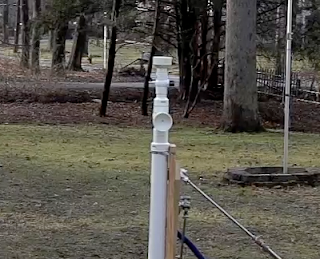Paper Stream
Occasionally we are asked to create a continuous stream of paper or money or something like that.
The classic approach is to lower a motorized rubber wheel (or the drive axle of a cheap radio control car) onto a stack of paper (or money, or whatever).
This creates the desired effect and is best used to make a sort of snowstorm of paper.
So, when I was asked recently to rig an office copier to spew out copies at an accelerated rate, that's the first thing I tried. However, it wasn't really the right way to do what they asked for.
The client wanted the paper to come out of the machine like it was a printer working at a faster speed, that is one copy after another, but with a regular space between copies. I realized that the traditional paper spewing rig was not controllable enough.
I realized that I needed to feed the copies one at a time into the spinning wheels. This posed a couple of problems.
First, without a stack of paper under the wheels there was too much friction to overcome so the wheels would not spin. I solved this problem by mounting the front axle of the car (the non drive axle) under the spinning wheels. I now had a pair of wheels spinning above a pair of wheels being spun, sort of like a pitching machine. If I fed a piece of paper into the wheels it was ejected nicely, and changing the speed of the wheels of course changed the trajectory of the paper.
Drive wheels could be either above or below, in this case they are on top. As you can see, copier was trashed to make this all work. Upper wheels are hinged on a long arm so they are resting on idler wheels by their own weight.
The second problem was how to feed the copies in one at a time in a regular fashion. I had actually encountered this problem before, but was able to feed the paper manually from behind a wall or something.
That wasn't an option in this case, so I made a simple conveyor belt using gator board and diffusion, operated by pulling a piece of trick line. I positioned the copies on the belt, each on on top of the next and about an inch ahead, so as I advanced the belt the papers were fed into the wheels one after another. By varying the speed of the belt I was able to vary the space between the copies being ejected from the machine.
 | |||||||||||||
| These aluminum rails were installed to make it easier to position the conveyor belt. I made two identical belts to reduce reset time. |
 |
| Here is a screen grab of the copier doing its thing. The conveyor is sticking out on the left side. It was hidden by the actor. |
If I get the opportunity to tackle this kind of project again I would like to motorize the conveyor belt so that the speed (and therefore the spacing of the copies could be more consistent. But overall I was pleased with the results, as were the clients. Best of all, I got some nice comments from the guys on the crew.

























